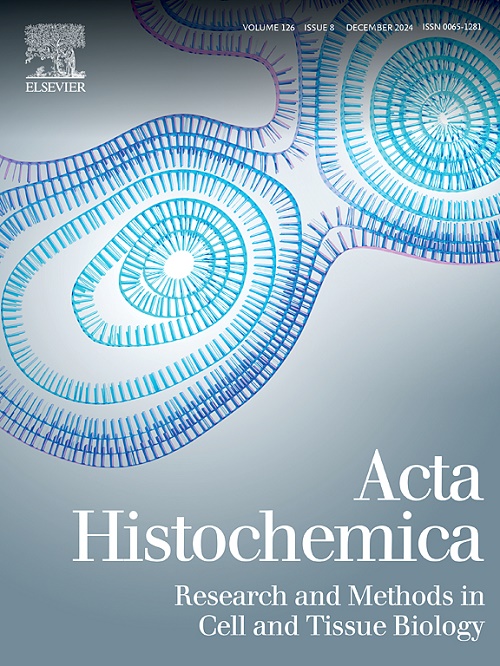Dihydroartemisinin inhibited tongue squamous cell carcinoma progression and tongue-to-lymph node metastasis through inhibiting RalB expression
IF 2.4
4区 生物学
Q4 CELL BIOLOGY
引用次数: 0
Abstract
Background
Lymph node metastasis is a key determinant of the poor survival rate in patients with tongue squamous cell carcinoma (TSCC). Therefore, inhibiting lymph node metastasis is a primary strategy for TSCC treatment. Our previous research found that dihydroartemisinin (DHA) inhibited the migration in human tongue squamous carcinoma Cal-27 cells. However, the effect and mechanism of DHA on lymph node metastasis are unknown in TSCC.
Methods
The expression level of Ras related GTP binding protein B (RalB) was measured in TSCC samples by immunohistochemical staining. Wound healing, invasion, and cell adhesion assays were used to investigate cell motility. Western blot was used to investigate RalB expression level. An orthotopic nude mouse model of TSCC was established to investigate the effect and mechanism of DHA on lymph node metastasis.
Results
First, DHA inhibited the progression of tongue tumor and tongue-to-lymph node metastasis of TSCC. Secondly, DHA inhibited RalB expression level in vitro and in vivo. Finally, DHA inhibited tongue-to-lymph node metastasis through RALB.
Conclusions
DHA inhibited tongue-to-lymph node metastasis through RALB, providing a novel therapeutic strategy for TSCC metastasis.
双氢青蒿素通过抑制RalB表达抑制舌鳞癌的进展和舌向淋巴结转移
背景:淋巴结转移是舌鳞状细胞癌(TSCC)患者生存率低的关键决定因素。因此,抑制淋巴结转移是治疗TSCC的主要策略。我们前期研究发现,双氢青蒿素(DHA)对人舌鳞癌Cal-27细胞的迁移具有抑制作用。然而,DHA对TSCC淋巴结转移的影响和机制尚不清楚。方法采用免疫组化染色法检测TSCC组织中Ras相关GTP结合蛋白B (RalB)的表达水平。伤口愈合、侵袭和细胞粘附试验用于研究细胞运动。Western blot检测RalB表达水平。建立原位裸鼠TSCC模型,探讨DHA对TSCC淋巴结转移的影响及其机制。结果首先,DHA抑制舌癌的进展和舌向淋巴结转移;其次,DHA抑制体外和体内RalB表达水平。最后,DHA通过RALB抑制舌向淋巴结转移。结论dha通过RALB抑制舌向淋巴结转移,为TSCC转移提供了新的治疗策略。
本文章由计算机程序翻译,如有差异,请以英文原文为准。
求助全文
约1分钟内获得全文
求助全文
来源期刊

Acta histochemica
生物-细胞生物学
CiteScore
4.60
自引率
4.00%
发文量
107
审稿时长
23 days
期刊介绍:
Acta histochemica, a journal of structural biochemistry of cells and tissues, publishes original research articles, short communications, reviews, letters to the editor, meeting reports and abstracts of meetings. The aim of the journal is to provide a forum for the cytochemical and histochemical research community in the life sciences, including cell biology, biotechnology, neurobiology, immunobiology, pathology, pharmacology, botany, zoology and environmental and toxicological research. The journal focuses on new developments in cytochemistry and histochemistry and their applications. Manuscripts reporting on studies of living cells and tissues are particularly welcome. Understanding the complexity of cells and tissues, i.e. their biocomplexity and biodiversity, is a major goal of the journal and reports on this topic are especially encouraged. Original research articles, short communications and reviews that report on new developments in cytochemistry and histochemistry are welcomed, especially when molecular biology is combined with the use of advanced microscopical techniques including image analysis and cytometry. Letters to the editor should comment or interpret previously published articles in the journal to trigger scientific discussions. Meeting reports are considered to be very important publications in the journal because they are excellent opportunities to present state-of-the-art overviews of fields in research where the developments are fast and hard to follow. Authors of meeting reports should consult the editors before writing a report. The editorial policy of the editors and the editorial board is rapid publication. Once a manuscript is received by one of the editors, an editorial decision about acceptance, revision or rejection will be taken within a month. It is the aim of the publishers to have a manuscript published within three months after the manuscript has been accepted
 求助内容:
求助内容: 应助结果提醒方式:
应助结果提醒方式:


